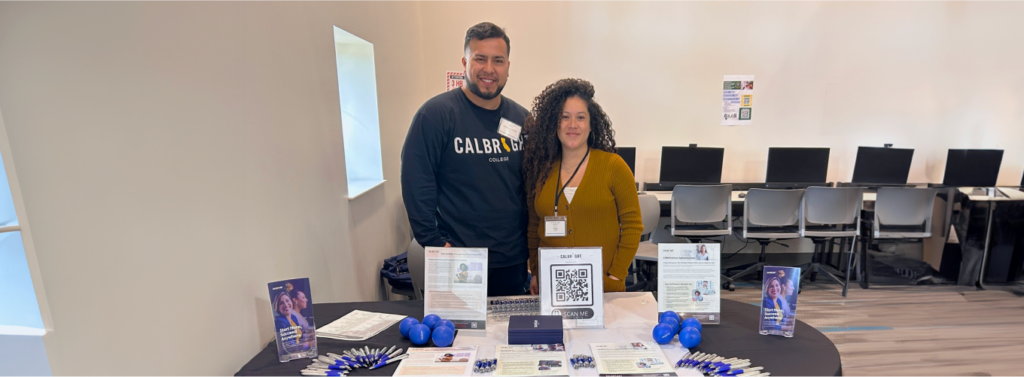One of the most exciting things about Calbright is the way we’re finding solutions to solve this complex problem.
Based on Calbright’s current results, making every aspect of the college experience—from the education model used to the personal interactions students have with faculty—more accessible, flexible, and personally welcoming and supportive, nurtures student persistence and success.
For Many Students, It’s Harder To Stay In Community College Than To Get In
Only 53% of community college students go from their first term in college to starting a second, according to the most recent data available from the California Community Colleges system CCC). Compounding this trend we see here in California and across the country, roughly 5% of adult learners in the CCC system complete their certificate program or associate’s degree in three years.
Community colleges are a proven way to boost careers and improve lives. They work. But because student persistence through their education is so low, a significant number of students are not getting the results they need from the colleges they attend.
At Calbright, student persistence rates hover around 95%.
Virtually all of our students keep going from one semester to the next and continue to pursue their educational goals.
Now Calbright is still a new college, with a whole new model of education, and is in its start-up period, so these statistics aren’t exact comparisons. What’s undeniable, however, is that the vast majority of Calbright’s students make progress and experience success in the earliest stages of their journey: they keep going towards their goals. Clearly something is going right.
What is it?
A Free Online Community College, Flexible and Career Focused
The first thing is that the Calbright approach to education puts students at the center of our design. Issues that make college hard to access in the first place are persistent and can make it difficult to stay in over time. Calbright’s structure was built to address this.
- Calbright is currently free to all Californians, so cost is never a factor.
- Calbright’s programs are entirely online and flexibly paced, so students can set their own schedules and study when and how they want. Students don’t have to stop their education because their job puts them on new shifts, or their child care schedule changes. Students can make their education fit their life, rather than withdrawing when life gets chaotic.
- Instead of degrees, Calbright’s programs prepare students to earn career-focused certifications in skills that hiring managers value – certificates in fields like IT Support, Cybersecurity, CRM Platform Administration, and Data Analysis. These can all be completed in less than a year. So structurally, Calbright’s students can reach their goals faster, which makes it easier to stay on track.
The fact that Calbright’s courses are career focused also helps, according to Ashley Odell, who designed and teaches in Calbright’s workforce readiness course.
“Having career focused courses, and a whole course focused specifically on career development itself, is a huge contributor to persistence, according to a number of studies,” she said. “In Calbright’s Workforce development course, we also have a ‘Why Are We Learning This’ section on the lesson activities to tell the students exactly how the course content in that section is preparing them for career success. Research shows that knowing why you are doing something makes you more motivated to continue, and we make that a part of everything we do.”
But Calbright also takes a proactive approach to helping students persist in reaching their goals. We haven’t just reimagined college to make it more accessible and connected to the labor market, we’ve created a high-touch online environment where students are connected to staff and communities who support them.
Keeping Online College From Being Isolating
Helping students persist is one of the key goals of Calbright’s student support specialists, according to Vice President of Student Support and Success Ted Lai.
“We utilize student data so that our student support team can engage in persistence work that we know has a good chance of success,” Lai said. “We know that students who go thirty days with no significant academic activity are not likely to return, so we connect with students before that happens to see if they’re having issues we can assist with. Similarly, if students are working at a regular pace—logging in at the same time most days—and then abruptly stop, we can reach out and see what’s going on.”
Students have said that maintaining regular contact with Calbright staff, centered around their schedules and their needs, makes a significant difference.
“Motivation became difficult for me,” said Calbright IT support graduate David Randall, reflecting on when his mother passed during the pandemic. “Some depression came in. I was surprised that one of Calbright’s counselors reached out to me, and we set up weekly check-ins. I was surprised at how influential that was. It got me motivated again, it was nice to have a human face to check in with after being so isolated. It was friendly and a relationship. It helped me get back on track.”
Amandeep Kandola, Calbright’s dean of student success, says that every month Calbright’s counseling teams monitor and reach out to students who have not logged in recently or those who display additional early signs of disengagement.
“Since a vast majority of our students are working adults who are managing a lot of different responsibilities, we wanted to have our outreach impact all programs so that no student is left behind,” Kandola said. “Every student gets the attention they need and every counselor is ready to offer support as soon as we notice there might be a problem.”
Because students already have an established relationship with their counseling and instructional faculty, they won’t be getting a message from a stranger. The person who checks in will be someone who they’ve spoken with before, whose name they know, who has been helpful in the past, and who they have a connection to. That makes a huge difference: the time to connect with students is before they’re struggling, not after.
Calbright also provides students access to colleagues and mentors from the start, so that they have someone to go to whenever they need.
“There are a variety of research articles written in the last two decades that support the benefits of mentorship, both peer mentorship and hierarchical mentorship,” Lai said. “Our own student feedback points to their desire to connect both academically and personally.”
The newest approach is the Experiential Learning and Leadership Program (ExLL), in which volunteer students across different programs, who have had success in their curriculum, are taught leadership and mentoring skills. They’ll then hold 1:1 peer mentoring sessions and facilitate group learning with other students.
“We believe that creating these connections supports students emotionally as well as along their academic and career journey with Calbright College,” said Lai.
Flexible And Student Focused Classes
Calbright’s faculty say that because the College’s courses can be updated for new students in real time, they have the flexibility to make adjustments to help students in ways conventional colleges can’t.
“I received feedback from students who were encountering challenges moving through IT Support-Core 1 courses, especially the more complex technical material.” said Ron Marzitelli, one of Calbright’s instructors. “In response, we created study sessions to assist students with those key concepts to avoid them getting frustrated and potentially dropping out. These are the type of support services needed to help students progress through the program, and we have the leeway to make those kinds of changes quickly.”
Michael Stewart, a computer service technology instructor, said that while every student at Calbright studies and progresses at their own pace, IT faculty are creating flexible cohorts that students can drop in and out of at any given time. “That way students who are studying the same thing can have community around the place they are in the program, even if that community changes as students come and go. There’s always someone to study with when they want it, wherever they are in the program.”
Computer Service Technology Instructor Elizabeth Biddlecome works in the IT industry, as does Stewart, and she says they both bring up the real world issues they’re experiencing in their professional lives, to connect it to the classroom lessons.
“When students can discuss current industry-related events and trends, they are in a better position to impress hiring managers,” Biddlecome said, “when they feel prepared, they are empowered to show up as more confident candidates.”
Biddlecome emphasized the degree to which getting to know students personally and using the flexibility of Calbright’s model to help students connect to the work they’re training for makes a big difference in keeping students engaged and on track.
“It’s more qualitative than quantitative: if you want students to stay enthusiastic you get to know students personally and key in on what their interests are, what their possible transferable skills are, and what their motivations are,” she said. “Sometimes students will come in with a very vague idea of wanting to get a job in tech because they know it will improve their lives, but they’re not really excited about it. But once you start keying in on what does excite them, on what their interests are, then you can find ways they can get excited about jobs in their field. That’s an area where we have been putting quite a bit of focus.”
All the faculty said that having digital common spaces for students to gather, like the Calbright student Slack channels, also makes a big difference.
“It offers opportunities for peer-peer connection and community building, as well as for public recognition and enthusiasm,” Odell said. “When students finish the Workforce Readiness course I teach, I send a text congratulating them and put it on the Calbright Celebrates Wins Slack channel. That way they get encouragement from me and their peers and other Calbright staff.”
A New Best Practice In Persistence For Adult Students
All of these structural factors and proactive support activities combine to make a college that is accessible, flexible, and personally supportive. When that’s combined with practical goals that matter to the students, and are achievable, we see students succeed. Rising persistence rates for non-traditional students potentially demonstrates a new best practice in solving one of education’s wicked problems.
Student persistence among even the traditionally hardest to reach students can be significantly improved. Calbright is leading the charge.



